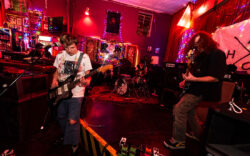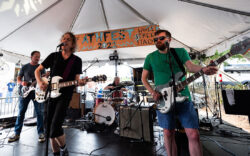After South By Southwest 2020 was cancelled—a seismic occurrence for the tech, film and music industries, not to mention a crushing economic blow to the city of Austin, TX itself—no one knew if there would be a 2021 event. Things appeared precipitously bad for SXSW as an organization and many employees were let go. The fact that it exists in any form this year is a testament to dogged determination and an overwhelming amount of technological heft.
Due to everything being online, attendees had nearly as many options as previous years with regard to panels and films, but could traverse them with a swiftness heretofore unimaginable for anyone that’s experienced it on the ground in Austin. If you started in with a panel that isn’t what you thought it’d be or just wasn’t very good or interesting, just go into another one. Missed one you really wanted to attend? It might have appeared as a replay later in the night. Certain films had a strictly limited viewing window, a fact totally analogous to live screenings being limited, and even though some music showcases would wind up being available for replay, many of those wouldn’t appear online until the festival’s end. Even so, the programming structure remains very similar to how one would experience SXSW in real time and in real life with events overlapping each other all week long.
The big thing this year was SXSW XR (i.e. cross-reality) in which one could experience the festival inside virtual representations of familiar Austin locales (Congress Avenue, Red River Street, et al). The technological know-how barrier to entry was pretty low and there were more than enough folks on hand to assist. I declined to participate this way for no good reason except that I had more than enough on my plate in the regular online world.
You’re never going to read comprehensive coverage of SXSW from a single writer. Even with the aforementioned ease of navigating this year’s event, not to mention the huge bonus of this year’s badges being good across all programming, the sheer size of the thing necessarily dictates that what you read will always be a very specific view and experience. The perhaps seeming-irony of a fully accessible and supremely streamlined event lending itself inevitably toward thinly sliced personal experience is, in actuality, not ironic at all. A major issue with SXSW as its structured on the ground was always the physicality of participation. The endless lines, the rush between panel sessions and showcases, and the sometimes conflicting rules between SXSW organizers and participating venues have thwarted my best intentions more than a few times over the years.
That said, it’s unreasonable to expect the organization to undermine the laws of physics, but what they came up with this year is the next best thing. The way this year’s event was structured rendered borders (albeit some films were available only to U.S. participants), travel restrictions and expenses, physical disabilities, lack of time and other concerns either non-existent or of very reduced concern as far as experiencing the event was concerned. If it can continue in this direction, even after it returns to its in-person programming, it will be a boon for expanding the already-global event.
Because programming was opened up this year to all attendees, I was able to catch films I wouldn’t have otherwise seen. First was Poly Styrene: I Am A Cliché which was a loving work co-written and narrated by the daughter of the late X-Ray Spex singer who was born Marianne Joan Elliott-Said. She passed away in 2011 and X-Ray Spex was only one part of her life, although the most publicly reverberating one and undoubtedly the reason she has a legacy as such today.
And while Styrene’s life in the spotlight, and to a large extent outside of it, wasn’t easy for her, it seems reasonable to presume that English composer and mathematician Delia Derbyshire would have been well gratified by even a sliver of similar recognition. Derbyshire’s incredible story, as presented in Delia Derbyshire: The Myths And The Legendary Tapes, is shown through recreated scenes, augmented with narration and appearances by Cosey Fanni Tuti (Throbbing Gristle, Chris & Cosey), and archival interview recordings, and is one of professional frustration but extreme artistic success. She stopped composing music altogether in 1975. After her death in 2001, 267 reel-to-reel tapes of her work were found, and remixes of some of this work by Tuti were used for the film’s soundtrack. Derbyshire is remembered for her construction (from sparse composer notes) of the original theme for “Dr. Who.” Less interested in music as she was sound itself, Derbyshire was a valuable contributor to the BBC’s Radiophonic Workshop—established specifically to produce sound effects and incidental audio for BBC programs—where her work was ignored and passed over seemingly as often as it was put into use. She didn’t even receive on-screen credit for her work on “Dr. Who” until 12 years after her death.
A huge part of the normal SXSW experience is the stumbling upon bands that I’d never planned on seeing and, more often than not, had never heard or heard of. Whereas on the ground this would happen via parties, certain showcases being packed out or too far away thus sending me elsewhere, and even groups just playing on the street, this year it came via some blind clicking around. It has always blown my mind when people complain that there aren’t enough interesting bands at SXSW these days or the lineups are weak or whatever. Translated, this nearly always means that there weren’t enough things they could access that would provide sufficient social currency. There is more than enough to hear and experience and while auxiliary (read: non-official) shows and parties are still a core portion of the overall SXSW experience this year’s structure made it very easy to distinguish notability from noise.
Montreal’s Paupière is billed as a synth-pop “Neo-Romantic” band and that’s basically true. But besides some presumed cosmic connection with the original New Romantic movement, their path doesn’t converge with that early 1980s movement at all. And it shouldn’t, either, because Paupière’s sound is big and enveloping and full of its own well-defined sense of melody and structure, which invites the listener to simultaneous experiences of comfortable retreat and enthusiastic abandon, albeit all within reason. The duo’s sound is much larger and consequently welcoming than it is on their records, too.
Austin-based producer and composer JaRon Marshall—keyboardist for the multi-Grammy nominated Black Pumas—played a deceptively powerful set recorded on a small, minimally lit stage with only a drummer and bassist to accompany him. He knocked through several tunes; the most thrilling for me being the one that if I’d heard from one room over would have thought was right off of Bitches Brew. During the same showcase, presented by Austin’s KUTX 98.9 FM, Deezie Brown—from tiny Bastrop, TX (Pop. 7,218)—and his delightfully thrilling set mixed deft lyricism with old school R&B. But the best aspect, musically speaking, was his having a live lead guitarist. The Texas hip-hop scene has been enormously healthy for years and the industry at large always has at least one eye on it, but this was the first time I’d seen a Texas rapper with live instruments (surely an accident of chance and not a one-off by any means) and it was great to hear.
There were so many more performances I saw, but the task of doing a deep dive on each will inevitably, and has in the past, lead to massively diminishing returns for both you the reader and artists which deserve more time and space than I’m able to readily give them. So don’t think of the following mentions as honorable ones but highlights to which I’m looking forward to returning. Critically speaking, some are better than others, but what are you gonna do, right? Anyway, they are Death By Denim (Australia), Mimi Bergman (Sweden), Sebastian Plano (Argentina), Chubby and the Gang (England), TV Priest (England) and the entire ensemble playing the “Outernational” presentation by England’s premier Jazz proponents, label, and promoters Jazz re:freshed.
Stewart Brand probably isn’t a known name in your household, but if your parents or grandparents were kind of D.I.Y. hippie types you might have an old Whole Earth Catalog somewhere in the family. Brand was its founder, was an associate of Ken Kesey’s Merry Pranksters, and started the Long Now Foundation in 1996. That’s as short as I can make his bio without making it impossibly longer. His is a life dedicated to futurism, environmentalism and taking as a moral imperative that mankind use technology for good. He’s also the subject of a new documentary named We Are As Gods.
WE ARE AS GODS | Trailer from Structure Films on Vimeo.
Brian Eno contributed the score for the film. The discussion between the two was illuminating with regard to learning more than I thought I ever needed to know about Brand’s incredible life and work but also very grounding by way of removing some of the mystery of what makes Brian Eno tick. Both were forthcoming, enthusiastic about their work and gentlemanly toward each other and the audience. Eno, in particular, was honest about his doubts concerning his own work and his lack of trust in his own opinions sometimes with regard to whether it has any value. So he saves everything and quite often comes back to it later knowing his initial opinion is unreliable. “This has happened so many times,” he said. “I think one’s judgement at the time of working has very little to do with the quality of what you’re making. It’s just to do with your mood at that moment.” Most edifying, and relatable on a personal and professional level, was his admission of needing an end game for anything he’s working on without which work would just go on forever always feeling incomplete.
“One of the most important elements of my work is having a deadline,” Eno said.
Which is as fine a place to conclude this report that, for most of the past year, seemed would never be needed, necessary or possible. SXSW more than rose to the occasion in 2021 and even normal, specific criticisms seem beside the point this year in light of how much was accomplished.
Like what you just read? Support Flagpole by making a donation today. Every dollar you give helps fund our ongoing mission to provide Athens with quality, independent journalism.










